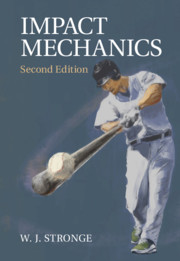Book contents
- Impact Mechanics
- Impact Mechanics
- Copyright page
- Dedication
- Contents
- Preface to Second Edition
- Preface to First Edition
- Acknowledgments
- Symbols
- 1 Introduction to Analysis of Low-Speed Impact
- 2 Collinear Rigid Body Impact
- 3 Planar or Two-Dimensional Rigid Body Impact
- 4 Three-Dimensional Impact of Rough Rigid Bodies
- 5 Tangential Compliance in Planar Impact of Rough Bodies
- 6 Continuum Modeling for Local Deformation Near Contact Area
- 7 Wave Propagation from Impact on Slender Deformable Bodies
- 8 Generalized Impact Analysis of Multibody Systems
- 9 Viscoelastic or Viscoplastic Impact
- 10 Impact against Flexible Structures
- 11 Propagating Transformations of State in Self-Organizing Systems
- 12 Impact of Sports Balls
- Book part
- Answers to Some Problems
- Permissions
- References
- Index
- References
References
Published online by Cambridge University Press: 19 October 2018
- Impact Mechanics
- Impact Mechanics
- Copyright page
- Dedication
- Contents
- Preface to Second Edition
- Preface to First Edition
- Acknowledgments
- Symbols
- 1 Introduction to Analysis of Low-Speed Impact
- 2 Collinear Rigid Body Impact
- 3 Planar or Two-Dimensional Rigid Body Impact
- 4 Three-Dimensional Impact of Rough Rigid Bodies
- 5 Tangential Compliance in Planar Impact of Rough Bodies
- 6 Continuum Modeling for Local Deformation Near Contact Area
- 7 Wave Propagation from Impact on Slender Deformable Bodies
- 8 Generalized Impact Analysis of Multibody Systems
- 9 Viscoelastic or Viscoplastic Impact
- 10 Impact against Flexible Structures
- 11 Propagating Transformations of State in Self-Organizing Systems
- 12 Impact of Sports Balls
- Book part
- Answers to Some Problems
- Permissions
- References
- Index
- References
- Type
- Chapter
- Information
- Impact Mechanics , pp. 344 - 352Publisher: Cambridge University PressPrint publication year: 2018

